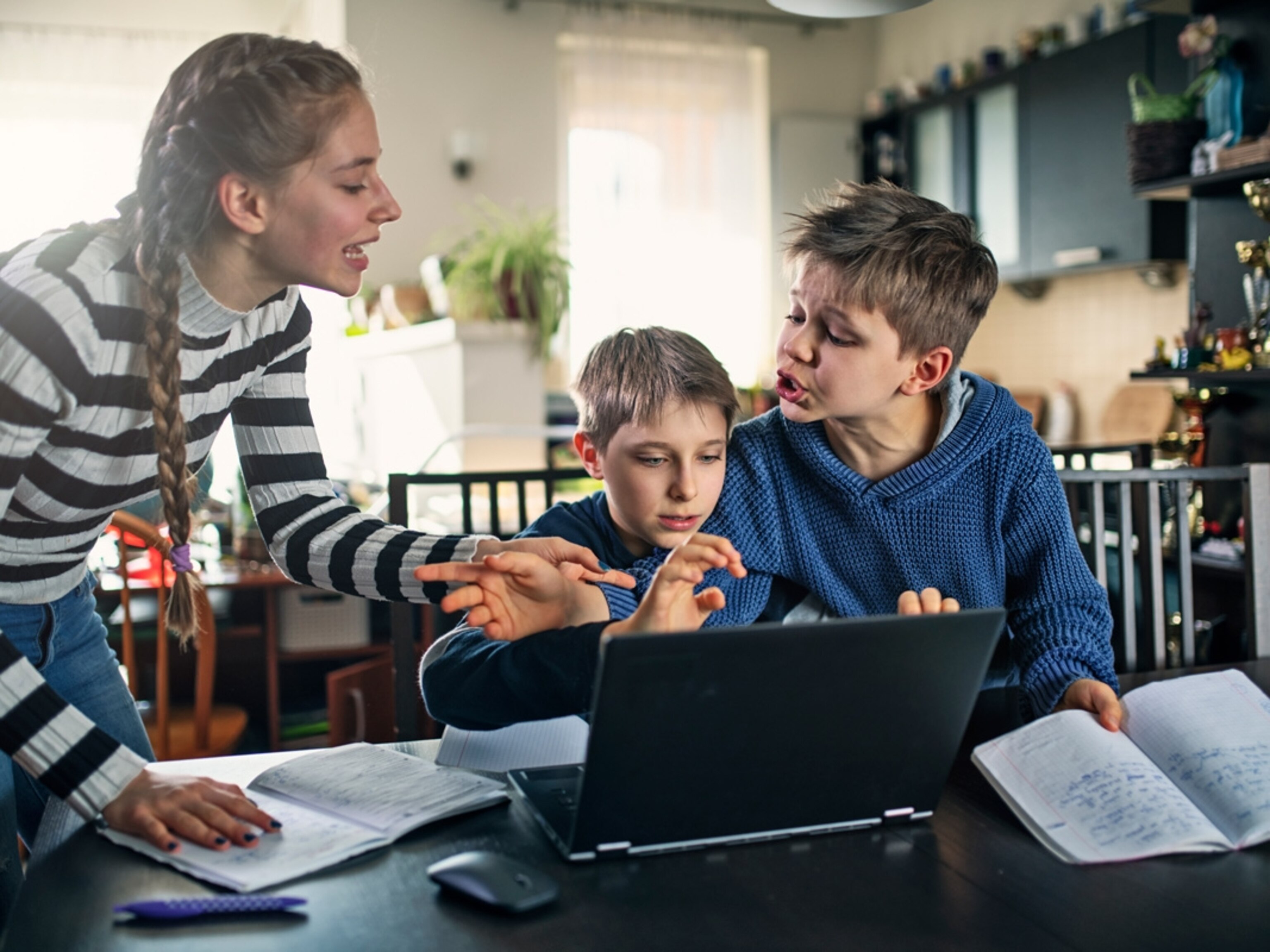
How to build a better (virtual) school year
These 6 lessons from 2020 can help parents better navigate the upcoming semester.
As students return to school this month after a much-needed winter break, they’ll bring with them lots of lessons honed during a rough 2020 school year filled with challenges and inconsistencies.
Parents have learned a lot, too. And as much as things might be different from how they once were, experts says what won’t change in the year ahead is a need for parent-supported learning.
“With the pandemic entering subsequent waves and swells around the world, it’s unrealistic to think schools will return to ‘normal’ this school year,” says Karen Bryant, a middle school principal from Gaithersburg, Maryland. “It presents unique challenges to parents raising and educating children.”
Still, though much of what the coming year’s classroom will look like is beyond parents’ control, they can use what they’ve learned in 2020 to make 2021 a better version of what their kids have experienced so far. Educators weigh in on how parents can do just that.
Lesson One: Your kid hasn’t figured everything out
If you’re assuming your kids have mastered their virtual classroom, you might be wrong. Bryant says many kids found the switch to online learning overwhelming—and are still adjusting. She advises keeping an eye out for children who may be struggling with getting their camera to work, managing their mute button, or uploading an assignment.
Instead of telling kids that they should be able to figure it out, Bryant suggests focusing on validating the difficult transition and highlighting what they do well. “Remind them that they know how to ‘do school,’” she says, adding that parents should set aside time to help kids navigate some of the more technical aspects of a virtual classroom.
The fall semester also made clear that the pandemic affects learners differently, says Genie Dawkins, a special needs educational advocate and host of the podcast Parenting Cipher. That means some parents are realizing their children still need more help from them as the new school year starts—especially if the child is used to having additional academic supports (like a secondary teacher support, bouncy-ball chair, special pencil, or quiet space for learning).
“If you have a special needs child, talk to your child’s school to see if your child uses an accessory in class that helps them focus,” she suggests, then work with the teacher to access what they would usually use, or solicit suggestions for obtaining a substitute while remote learning.
Another option for any student: Turn after-school time into a coworking session to help them make adjustments, organize assignments, and stay prepared. “As you check your job emails, they can check the school ones,” Dawkins says.
Lesson Two: You need a new way to communicate.
Asking your children, “How was your day?” the moment they shut off their computers might not net you the response you’re after. Instead, build in a routine of sharing—either through regularly scheduled conversations or casual chatter as you chop vegetables for dinner or get ready for bed at night.
“These conversations should not be filled with emotion that may cause your child to shy away from sharing freely,” Bryant says.
Getting the silent treatment? Don’t be afraid to share how tough your day was, how you overcame a challenge, or just how much you appreciate the best efforts you see them putting forward. The goal is to help your child build an emotional foundation that offers them a protective barrier from the challenges they’re facing.
“Affirm who they are, how they are, and where they are in this moment,” Bryant says. “When children feel good about themselves, they show up stronger in the classroom. When they feel strong in the classroom, they’re more likely to engage in the lesson and experience learning.”
Lesson Three: Learning isn’t just about schoolwork.
While textbooks have their place, giving kids opportunities that encourage “softer skills” can also serve as learning moments, says Deena Shaffer, president of the Learning Specialists Association of Canada.
“Math, science, and reading have often been key parent priorities for their kids’ learning,” she says. “But now we see that it’s just as crucial to learn coping and stress reduction skills, online etiquette, and patience.”
Parents can help kids by labeling some of the skills and character traits that their children are learning: generosity, when they help bring groceries to a neighbor’s porch; flexibility, when they deal with schedule changes; responsibility, when they complete household chores; and creativity, when they nurture relationships at a distance. The emphasis will also underscore what your family values as important and help strengthen family bonds. (Check out these tips for building a kinder kid.)
Lesson Four: Don’t forget recess
Parents were so focused on managing the in-class aspects of school last year that some of the physical activity and outdoor play that comes with a schoolyard recess has been lost. Dawkins encourages parents to build it back in by organizing a “Family Gym Time” with planned activities or unstructured physical play.
“Choose a time every day for everyone to play outside or engage in indoor physical activity,” she suggests.
Bonus: Studies have shown that physical activity helps kids perform better academically. While pandemic regulations will likely mean you can’t replicate the built-in socialization opportunities of an in-person school day, parents who work to incorporate regular breaks and physical activity in their child’s school day might see focus improve. (Here are some ideas to keep your kids fit.)
Lesson Five: It’s good to be that ‘fly on the wall.’
The 2020 virtual school year offered parents an opportunity to see what their kids are like as students—information that can better inform how they help their children learn this year. “Never before have parents had this up-close opportunity to see their child ‘in action’ in the classroom,” Bryant says.
This year, as you kinda-spy on your remote learner, ask yourself: What is my child like as a student? Are they fidgeting at their desk? Are they able to follow instructions? How do they interact with their peers? With the content?
In a normal school environment, teachers would be watching for these cues and adjusting for a child’s learning style. Now, parents can help bridge that gap. (This article has advice on maintaining strong relationships with your child’s teacher.)
“Parents can use this specific information to enhance communication with teachers about their child’s progress with the goal of providing targeted support at home,” Bryant says.
After watching how her own children learned over the last year, Shaffer agrees. “Previously, I would get only the snippets of what they would share at the end of the day, report cards, and parent-teacher interviews,” she says. “Now, I experience firsthand who they are as students—how they relate to their teachers, respond in class, and push through challenging problems. This has been a sweet, silver lining in our virtual school adventure.”
As a result, Shaffer says she’s able to help them better navigate their schoolwork. Other parents with different observations might remove distracting knick-knacks or structure more break times.
Lesson Six: We don’t have to ‘do’ perfect.
As many parents have learned this past year—and likely the months ahead—pandemic parenting is not about being perfect. It’s about being “good enough.”
“Parents may not be able to control how and when their local school district will safely return to in-person learning,” Bryant says. “But they can control the home environment they create and reimagine it as a safe harbor from which their family successfully navigates virtual learning.”
Shaffer says that means making decisions about virtual schooling that serve your family’s mental health priorities as well as your children’s education priorities.
“Anything you can do that amplifies family harmony, eases unnecessary friction, ensures safety for open dialogue and the airing of frustrations, and disrupts potentially now ill-fitting expectations about what our kids ‘should’ be learning, go for it!” Shaffer says. “We—and our families—benefit when we loosen our grip, exhale, and connect as a family.”




